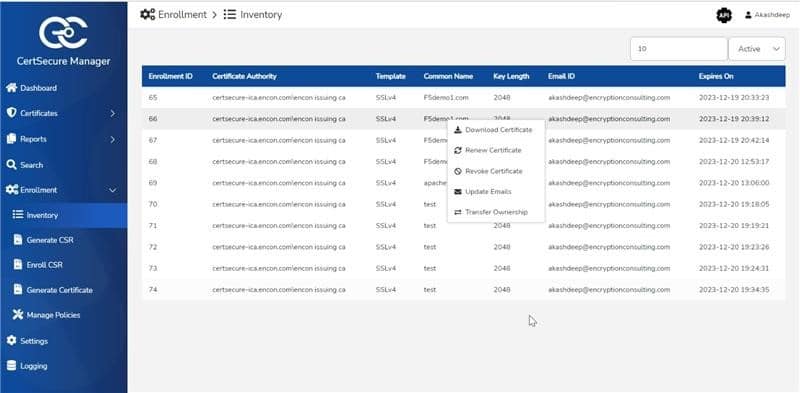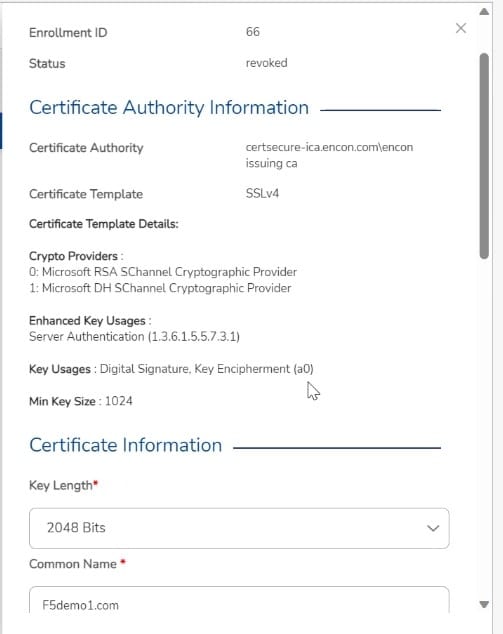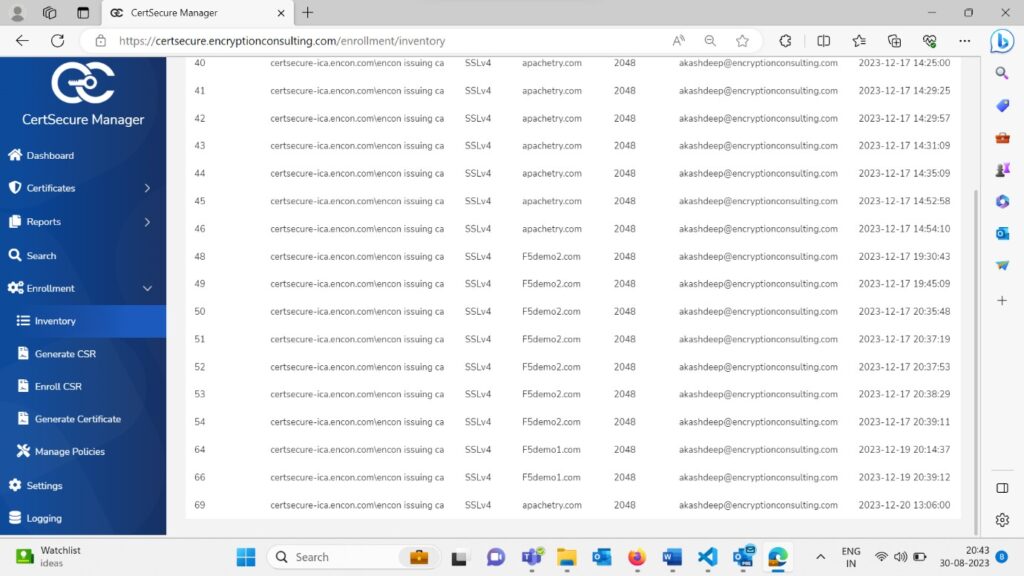SSL Certificate Lifecycle Mastery with CertSecure Manager

In cybersecurity, SSL (Secure Sockets Layer) certificates are crucial in establishing encrypted connections between web servers and clients. These certificates ensure that the data exchanged between a user’s browser and a website remains private and secure. Over time, SSL certificates expire, encounter technical glitches, or become compromised, necessitating actions such as renewal, reissue, and revocation. In this article, we delve into the intricacies of these processes, shedding light on how they contribute to maintaining a secure online environment.
Understanding SSL Certificates
First, explore SSL certificates and their significance in cybersecurity before diving into the renewal, reissue, and revocation procedures.
SSL Certificates
SSL certificates are digital documents that verify the authenticity of a website and enable secure data transmission over the Internet. They are issued by Certificate Authorities (CAs) after a thorough validation process. When users visit a website with a valid SSL certificate, their browser initiates an encrypted connection, indicated by the “https” prefix and a padlock icon in the address bar. This encryption ensures that sensitive information, such as login credentials and credit card details, remains confidential.
The Need for Certificate Management
SSL certificates have a finite validity period, usually one to three years. As certificates approach their expiration dates, managing them effectively is imperative to prevent disruptions in secure communication. Here’s where the renewal, reissue, and revocation processes come into play.
Certificate Renewal in CertSecure Manager
At Encryption Consulting, we understand the critical importance of seamless certificate renewal to maintain your website’s security and trustworthiness. With our CertSecure Manager platform, we’ve streamlined the certificate renewal process to ensure that your certificates are always up-to-date and your users’ browsing experience remains secure.
Renewing Certificates with CertSecure Manager
Renewing your SSL certificates through CertSecure Manager is a straightforward and efficient process. Follow these steps to ensure the continuity of your certificates’ validity:
-
Log in to CertSecure Manager
Access your CertSecure Manager account using your credentials.
-
Identify Certificates for Renewal
Navigate to the certificate management section to view a list of your existing certificates. Identify the certificates that are approaching their expiration dates and require renewal.
-
Initiate Renewal Request
For each certificate that needs renewal, initiate a renewal request directly from the CertSecure Manager interface. The renewal request will use the same details as the original certificate request but will be signed with the private key of the existing certificate.
-
Validation and Verification
Depending on the certificate authority’s requirements and the type of certificate, CertSecure Manager may guide you through the validation and verification process. This step ensures that you still have control over the domain or organisation associated with the certificate.
-
Complete Renewal
Once the validation process is complete, the CertSecure Manager will guide you through the final steps to complete the certificate renewal process. This includes generating the renewed certificate and installing it on your server.
Advantages of Renewing with CertSecure Manager
-
Efficiency
CertSecure Manager streamlines the renewal process, saving you time and effort compared to manual renewal procedures.
-
Automation
CertSecure Manager can be configured to send renewal reminders, ensuring that you never miss a certificate’s expiration date.
-
Visibility
The platform provides a comprehensive overview of all your certificates and their expiration dates, making it easy to manage and plan renewals.
Renewing SSL certificates doesn’t have to be a daunting task. With CertSecure Manager, you can proactively manage and renew your certificates, ensuring a secure online presence for your users.
Certificate Reissue
Certificate reissue involves the issuance of a new SSL certificate with updated information while retaining the original validity period. Reissuing a certificate becomes necessary when there are changes in the domain name, organisation name, or other identifying details associated with the certificate.
The reissue process involves these steps:
-
Requesting a Reissue
Administrators generate a reissue request with the updated information. This request is then submitted to the CA.
-
Validation
Similar to the renewal process, the CA might require validation to ensure that the entity requesting the reissue has control over the domain or organisation.
-
Issuance of the Reissued Certificate
Once validated, the CA issues a new certificate with the updated information. The private key of the original certificate is used to sign the reissue request.
-
Installation of the Reissued Certificate
The new certificate is installed on the server, replacing the old one. It’s important to update any configurations that reference the old certificate.
Certificate Revocation with CertSecure Manager
At Encryption Consulting, we understand the critical importance of promptly revoking compromised or outdated certificates to ensure the security of your digital assets. With our innovative solution, CertSecure Manager, the certificate revocation process is streamlined and efficient. Here’s how you can revoke certificates using CertSecure Manager:
-
Login to CertSecure Manager
Access your CertSecure Manager dashboard by logging in with your credentials. If you’re not yet using CertSecure Manager, you can request a demo to explore its features.
-
Navigate to Certificate Management
Once logged in, navigate to the certificate management section within CertSecure Manager. This is where you’ll find a comprehensive list of all the certificates under your management.
-
Select the Certificate to Revoke
Locate the certificate that needs to be revoked from the list. You can search, filter, or browse to find the specific certificate you want.
-
Initiate Revocation
Click on the certificate to access its details. You’ll find an option to initiate the revocation process within the certificate details page. CertSecure Manager provides a user-friendly interface to streamline this process.
-
Confirm Revocation
After selecting the revocation method, the CertSecure Manager will guide you through the necessary steps to confirm the revocation. This might involve providing additional information or authentication.
-
Monitor Revocation Status
Once the revocation process is initiated, the CertSecure Manager provides real-time status updates. You can monitor the progress of the revocation from your dashboard.
-
Update Certificates
After successfully revoking the certificate, the CertSecure Manager ensures that relevant systems and applications are updated to reflect the revoked status. This prevents any unauthorised use of the compromised certificate.
The certificate revocation process becomes seamless using CertSecure Manager’s intuitive interface and robust features, allowing you to maintain a secure and trusted digital environment. Whether managing a single certificate or a large portfolio, CertSecure Manager simplifies and enhances the entire certificate lifecycle management process, including revocation.
The Role of Certificate Authorities (CAs)
Certificate Authorities play a pivotal role in all the processes discussed above. They are trusted entities responsible for verifying the authenticity of certificate applicants, issuing certificates, and facilitating their management. CAs use stringent validation procedures to ensure that the entity requesting a certificate controls the domain or organisation listed in the certificate.
When it comes to renewal, reissue, and revocation, CAs are involved in:
-
Validation
Both renewal and reissue processes might require validation to confirm the legitimacy of the requestor.
-
Issuance
For both renewal and reissue, CAs issue new certificates after validating the request.
-
Revocation
When revocation of a certificate is required, CAs update their revocation lists or respond to OCSP queries with the revocation status.
Best Practices for Effective Certificate Management
Cybersecurity experts should follow the best practices for certificate administration to guarantee the safety and smooth functioning of websites and apps:
-
Proactive Monitoring
Regularly monitor certificate expiration dates to initiate renewal well in advance.
-
Automated Renewal
Consider using automated tools or scripts to manage certificate renewals and reduce the risk of oversight.
-
Inventory Management
Maintain an inventory of all SSL certificates and their associated details to facilitate tracking and management.
-
Document Procedures
Document renewal, reissue, and revocation procedures to ensure consistency and accuracy in certificate management.
-
Stay Informed
Keep up with the most recent advancements in certificate administration and cybersecurity to modify your procedures as necessary.
How can CertSecure Manager help?
For a comprehensive and streamlined approach to SSL certificate management, there’s no better companion than Encryption Consulting’s CertSecure. This cutting-edge solution is designed to simplify the intricacies of certificate lifecycle management.
From timely renewals to seamless reissues and the crucial task of certificate revocation, CertSecure offers a user-friendly interface that empowers cybersecurity professionals to stay ahead of potential pitfalls.
CertSecure doesn’t just stop at efficient certificate management; it’s a robust toolkit for proactive monitoring, automated workflows, and meticulous documentation. By choosing CertSecure, you’re not only choosing a solution but also a partner in your journey to fortify the security of your online presence.
In a digital landscape where security and trust are paramount, CertSecure is a beacon of excellence in SSL certificate management. Embrace the future of cybersecurity with CertSecure, and ensure your certificates are managed and mastered. Your data’s security deserves nothing less.
Conclusion
In the ever-evolving landscape of cybersecurity, the integrity and security of SSL certificates are paramount. These digital encryption sentinels are essential for protecting sensitive information and guaranteeing the reliability of online communication. As SSL certificates come with a finite shelf life and various potential challenges, the adept handling of processes like renewal, reissue, and revocation becomes non-negotiable.












